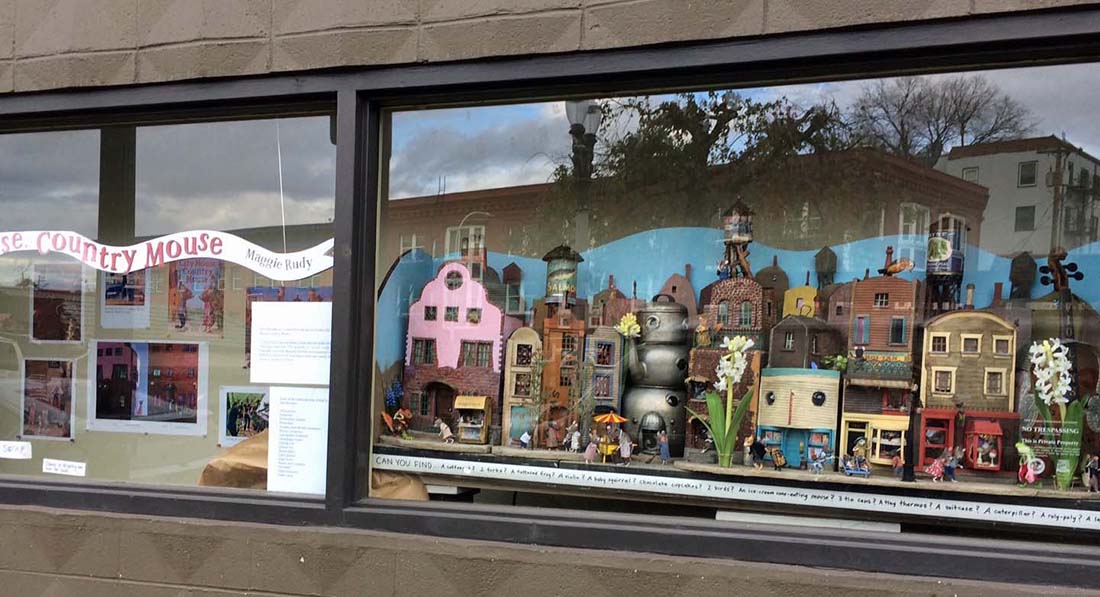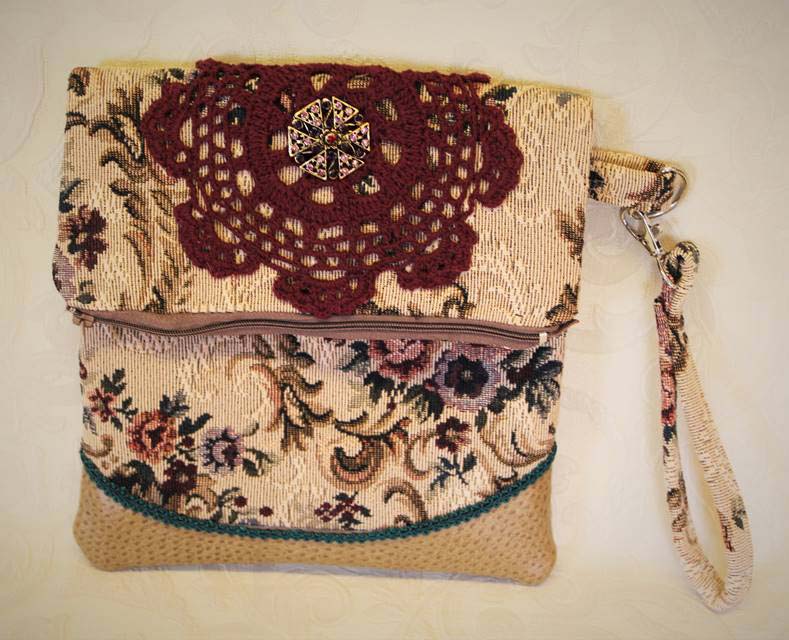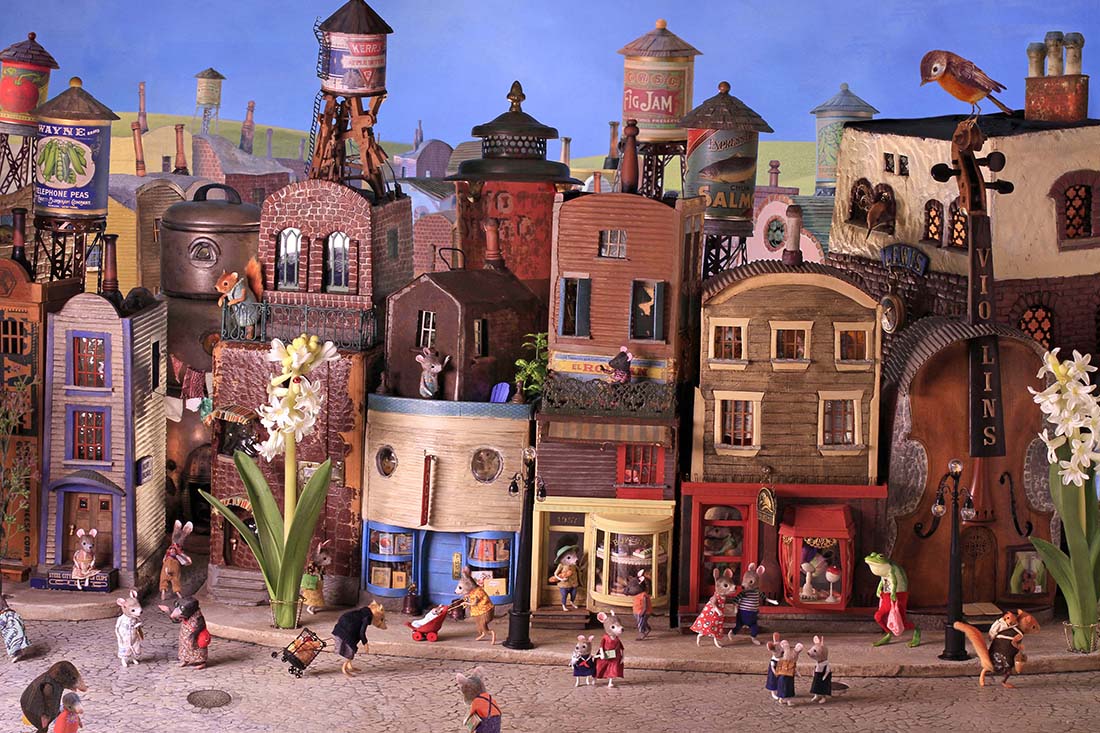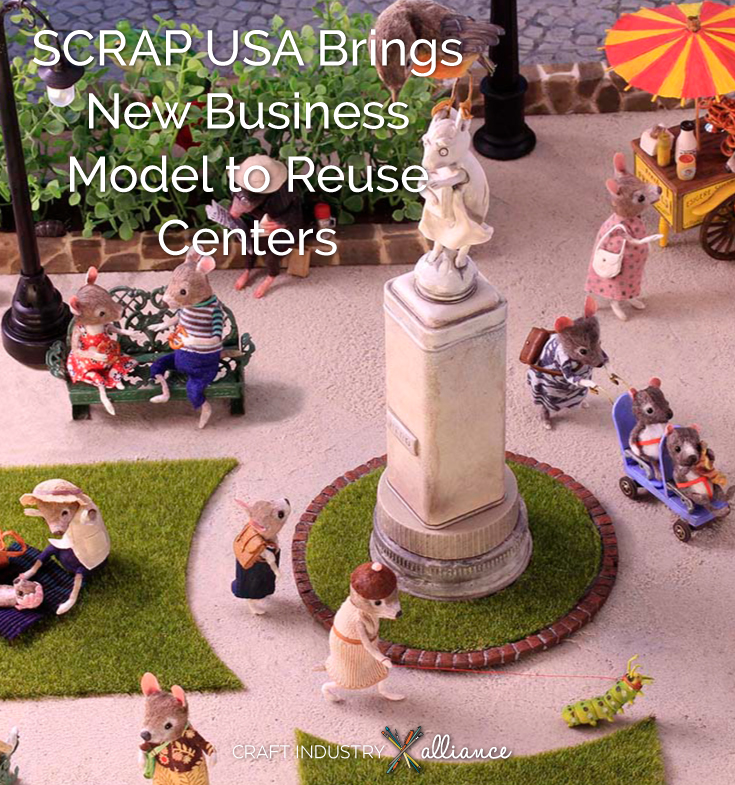
Maggie Rudy used mostly recycled material found at SCRAP PDX in Portland to fashion this window display at the reuse shop.
Photo courtesy of Maggie Rudy
“Without the wonderful (items) I find at SCRAP B-More, I would not have a business,” says Harris, who also loves that the material is not going into a landfill or other waste stream.
Reuse, repurpose, and recycle is more than a slogan at SCRAP USA — it’s a business model that aims to make creative reuse stores a sustainable endeavor applicable to any community. The concept was hatched in 1998 in Portland, Oregon, by teachers looking to share leftover classroom materials. They brought these materials to A Teacher’s Space, a resource center for area public school teachers, and left them on a table for others to use.
In 1999, teacher Joan Grimm and some fellow educators wanted to bring the concept to the next level so they applied for and received a grant from the Department of Environmental Quality to open a small creative reuse center in Portland. SCRAP soon became a 501(c)(3) nonprofit. Their mission grew and today the organization has created a business model to help others do the same.
“We created a network model to help fuel the reuse movement in the U.S.,” says Kelley Carmichael Casey, PsyD, SCRAP USA’s Director of Global Research. “Our goal is to help guide and support the start-up of creative reuse centers to bolster their chances for success. We’ve developed operations tools and best practices to share with budding centers.”



Allison Harris’s bags and purses are all made using fabric, beads, laces, buttons, beads, thread and more found at SCRAP USA’s Baltimore creative reuse store.
Photos courtesy of Allison Harris


“We offer a platform so that no creative reuse center has to re-create processes that we’ve already created,” says Casey. “We want them to hit the ground running by offering the support they need to focus on their mission.”
This includes helping with a business plan, accounting, merchandising, website, marketing, human resources, legal issues, training, and more. SCRAP stores pay a small administration fee.
Although the shops may vary a bit in offerings, depending on the wants and needs of individual neighborhoods, all collect tax-deductible donations of clean, re-useable, craft-worthy items, such as fabric, paper crafting goods, yarn, beads, and more, and sell these at 65-75% off regular prices. Donations come from industry, local businesses, and individuals cleaning out their craft closets.
Some SCRAP shops started as independent reuse centers but joined the SCRAP network to get much needed support because making a go of a reuse center is harder than it looks.
“It seems like gathering a bunch of donated cast-off craft materials and selling them would be intuitively easy,” says Casey. “In fact, it’s challenging because of the wonkiness of the inventory. There’s no standard inventory item with an understood retail value. Items are handled and processed individually, often requiring research to determine quality and value.”

This type of business “requires all kinds of administrative and financial know-how and systems. That’s a tall order,” she adds. “We have a strong business plan with super-savvy leadership. We rely on community relationships and the support of the crafting community.”
Having an “administrative hub that handles all of the little things that would be an additional cost for small nonprofits, such as payroll, finance, resource sharing, etc,” are among the benefits of being a part of the network, adds Elizabeth Start, formerly director of SCRAP PDX and now executive director of SCRAP USA.
Nancy Hotchkiss, who opened the 1,200-square-foot SCRAP B-More in 2016, formerly worked in conservation education at zoos and aquariums and has long been interested in the reuse market. She has volunteered at such places as the Loading Dock, which recycles building materials, and was looking for her next passion. “I decided I want to spend the next few years with a glue gun in my hand,” she says with a laugh.
Her internet research found SCRAP USA, and Casey helped her make a business plan, do a market analysis to scope out the competition, and to study the community “to make sure this (business) will meet a need and be embraced.”
“The business plan was really important,” Hotchkiss says. “Nonprofits are emotionally driven, but emotions won’t pay the bills. (Casey) helped us think it through, be smart in our pricing structure, and figure out our niche in the market.”
Finding their niche, Hotchkiss says, was especially important because there are several reuse centers in Baltimore. For example, because there are groups that distribute building materials, clothing, teacher supplies, etc., SCRAP B-More redirects those items to other facilities.
“We had to define our niche a little more, to see who is here, who is doing what, what is our market,” Hotchkiss explains.
“(SCRAP USA) gives us a brand, a framework for how to do things,” she adds. “They set up websites for us and we have monthly calls with the other directors, so there is a colleague who is going through the same difficulties and can offer help.”

Maggie Rudy gets most of her “bits and baubles” for her art pieces at SCRAP PDX, a creative reuse center in Portland, Oregon, and part of the SCRAP USA creative reuse center.
Photo courtesy of Maggie Rudy

“We joined the larger network to have better access to grants and more funding to keep us going,” says Turner. “Because our store is small with little storage space, sometimes we get overrun with fabric, ribbon, and crayons/pencils/markers. Anything vintage sells very quickly.”
Children’s book author and illustrator Maggie Rudy shops at SCRAP PDX about once a week to gather material to create miniature scenes she then photographs for her books, including her most recent, City Mouse, Country Mouse.
“I buy a little of everything at SCRAP,” says Rudy, whose recent window diorama at SCRAP PDX used fabric, house paint, sewing notions, foam scraps, paper, chess pieces, LED lights, Erector Set parts, suitcases, piano hammers and keys, ceramic insulators, and more.
“I use all sorts of bits and bobs to create my work, so SCRAP is invaluable to me,” she says. “I never know what I’m going to find there, but I know I’ll be able to afford it.”
Casey believes that socio-economic conditions, consumer awareness, and creative crafters are making reuse centers more viable as businesses, where someone’s trash is, indeed, someone else’s creative treasure.



Mixed media Artist Alli Bratt creates paintings and assemblage pieces using items found at SCRAP PDX, a creative reuse center in Portland, Oregon. Bratt, who was a customer at the store before working there, finds everything from magazine pictures to paint, jewelry pieces, metal bits, and more. “I always appreciate the hunt,” she says.
Photos courtesy of Alli Bratt

Roberta G. Wax
contributor
Roberta Wax is an award-winning journalist and imperfect crafter. A former news reporter, her freelance articles and projects have appeared in a variety of newspapers and magazines, from the Los Angeles Times and Emmy magazine to Cloth Paper Scissors, Somerset Studio, Craftideas, Belle Armoire, etc. She has also designed for craft companies. Although she has no art background she was a crafty Girl Scout leader. www.creativeunblock.com


If you’re wondering if there’s a creative reuse center near you, here’s a list!
http://www.lancastercreativereuse.org/directory-creative-reuse-centers.html
Is there another URL? this link is broken.
Try this: https://swoodsonsays.com/a-creative-reuse-center-near-me-map-resource/
Thank you! This list is very helpful, it will help close the loop on my 2024 reduce reuse recycle yarn bombing projects sponsored by the Mass Cultural Council.
What a wonderful idea! I’ve seen small versions of this operating at needlework guilds, but nothing on this scale. No idea if there is anything comparable here in Germany. I’ll keep my eyes peeled :).
Great article Roberta and thank you for including my altered couture handbags.
An unexpected hospitalization impeded my progress in getting my website up and my Etsy shop fully stocked with my bags. I have 30 or so bags up and I am adding a hundred or so more this week.
Anyone interested can find me under
Etsy :
http://www.etsy.com/shop/LotusRisingHandbags
And in the next couple weeks, my website will be up as well.
http://www.lotusrisinghandbags.com
I live in Richmond, Va and have become an evangelist for SCRAP RVA! I love telling people about the great stuff there and have made it my first stop when looking for supplies, before going to the big box places.
I am going to have to do some research and see if there is a creative reuse center near me. This was such an informative article!
So glad to hear it.
How could you miss FABSCRAP in NYC where fabric and fashion related industries must and do recycle! They would be worth another whole article themselves…
We agree! They’re awesome and we hope to visit sometime!
Things have changed since this was written: SCRAP Denton and SCRAP Humboldt are both permanently closed. According to SCRAP Box’s website, they need to raise $20K or they will go under, too.
The Scrap Exchange in Durham, NC is another wonderful reuse resource. I can spend hours in there.
I’ve been there and it’s amazing.
I’m sad. I came here hoping to find out if there is industrial waste I can incorporate into a new product I’m creating but there are no locations near me and I don’t see anything I can buy online.
Here in Vancouver, BC we’ve had Urban Source for many years, which offers all kinds of leftovers from manufacturers here in the Lower Mainland, along with basic craft supplies. It’s been our go-to for Hallowe’en and Christmas crafts.
I’m currently writing a business plan for my dream creative reuse center in my hometown in NJ! Thanks for this great article!